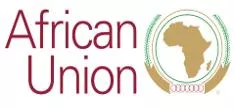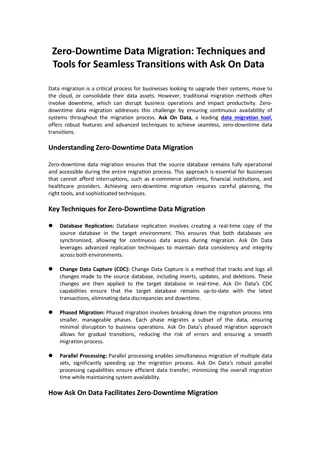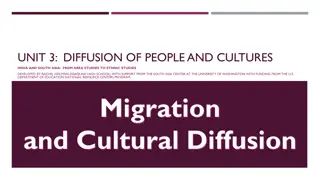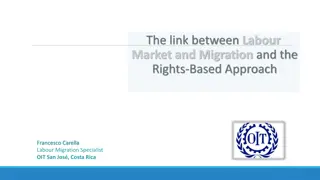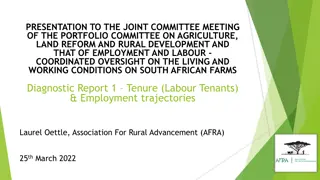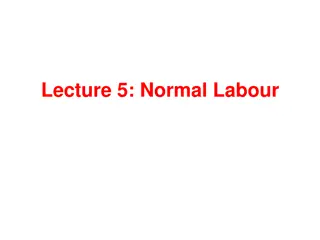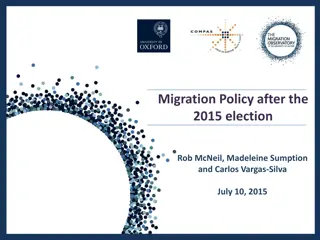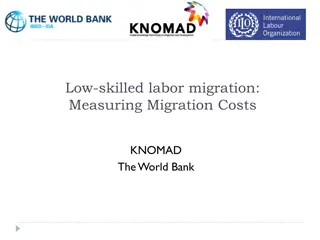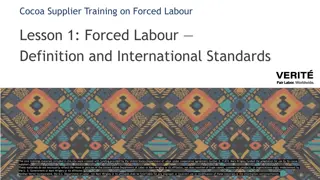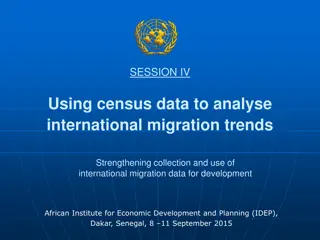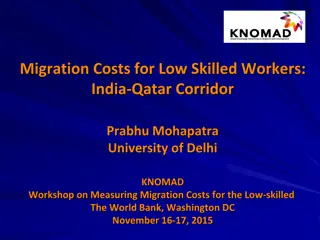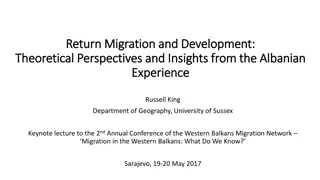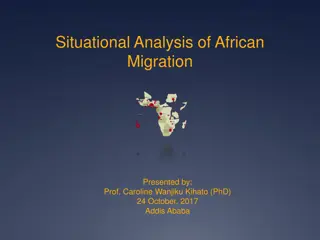Insights on Labour Migration Statistics in Africa
Preliminary findings from the 3rd edition of the Labour Migration Statistics in Africa show an increase in the working-age population and the labor force. However, there are gaps in data related to international migrant workers, including inconsistencies and missing information. The report emphasizes the importance of education in enhancing the labor market situation and skills development for better policy-making in Africa.
Download Presentation

Please find below an Image/Link to download the presentation.
The content on the website is provided AS IS for your information and personal use only. It may not be sold, licensed, or shared on other websites without obtaining consent from the author. Download presentation by click this link. If you encounter any issues during the download, it is possible that the publisher has removed the file from their server.
E N D
Presentation Transcript
LABOUR MIGRATION STATISTICS SIDE EVENT DURING PAFOM 6 METING ADDRESSINGLABOURMIGRATIONDATAGAPS INTHE 1ST-3RDEDITIONSOFTHELABOUR MIGRATIONSTATISTICSREPORTSFORBETTER POLICYDEVELOPMENTIN AFRICA. 10 September 2021, Dakar Senegal Nougbodohoue Samson Bel-Aube & Brian Okengo Africa Union Commission 1
2 I. Preliminary findings: 3rd edition of the Labour Migration Statistics in Africa The 3rd edition of the Labour Migration Statistics in Africa indicates that: There was 1.29 billion people in Africa Working-age population consist of 730 million people (2019); an increase of 26 per cent from 2010 Labour force (Employed and Unemployed) consist of 511.5 million people in 2019.
3 Status of International Labour Migration (Africa) The estimates of stock of international migrants and international migrant workers in 2019 Migrants (26.3 million) However, when we look at employed migrant workers only the following countries were able to provide data in 2018 (Cabo Verde, Cameroon, Chad, Egypt, Liberia, Mali, Namibia, Niger, Nigeria, Seychelles). Migrants 15+ (20.2 million) Migrant workers (14.5 million)
4 Migrant Worker Population by sex 2010-2019 (Millions) 14.5 13.9 16.0 13.3 International migrant workers 12.9 12.5 11.7 14.0 11.2 10.6 10.1 12.0 9.5 8.9 8.5 10.0 8.2 8.0 7.8 7.3 7.0 (millions) 6.6 6.3 8.0 5.9 5.6 5.3 5.1 4.9 4.8 4.4 6.0 4.2 4.0 3.8 3.5 4.0 2.0 0.0 2010 2011 2012 2013 2014 2015 2016 2017 2018 2019 Year Total Female Male There is an increase of migrant workers in the years Only 10 countries are able to report on migrant workers with details characteristics;
5 Labour Migration Data Gaps Lack of data on economic activities, education, skills, and occupation Inconsistencies across years Need to go beyond the reporting of stock of migrants Lack of adjustment between sources Missing data
6 Labour Migration Data Gaps Lack of data on economic activities, education, skills, and occupation Inconsistencies across years Need to go beyond the reporting of stock of migrants Lack of adjustment between sources Missing data
Labour Migration Data Gaps: Education Education is key to improving the labour market situation of people. Education is essential for acquiring the technical or vocational skills required for employment and for coping with technological change. The level of education of the population is a measure of the outcome of investments in education Understanding the level of education of migrant workers will help policy makers in developing policies to address the skills gaps in given sectors where migrants are employed With education level it is easy to understand the labour market situation in the country and leverage on BLA s with other countries and plan on research activities in given sectors of interest
Educational attainment of total working-age populations, by sex, 201019 (percentage) 50.0 45.0 39.9 39.1 40.0 36.9 35.5 35.0 29.6 30.0 26.1 24.2 25.0 22.7 20.0 20.0 15.0 9.8 8.7 10.0 7.7 5.0 0.0 M+F Male Female Total population 15+ Never attended an education programme Basic education Intermediate education Advanced education
Educational attainment of migrant working-age populations, by sex, 201019 (percentage) 50.0 45.0 40.0 34.6 34.2 34.2 35.0 31.9 30.7 29.0 28.1 30.0 25.0 25.0 22.8 20.0 15.0 11.1 10.1 8.2 10.0 5.0 0.0 M+F Male Female Migrant population 15+ Never attended an education programme Basic education Intermediate education Advanced education
Educational attainment of migrant working-age populations, by sex, 201019 (percentage). Country X. 70.0 63.1 62.2 60.9 60.0 50.0 40.0 28.0 30.0 25.1 21.1 20.0 9.6 8.3 10.0 6.7 6.1 4.5 4.4 0.0 M+F Male Female Migrant population 15+ Never attended an education programme Basic education Intermediate education Advanced education
Labour Migration Data Gaps: Employment status Gives indication of the economic risks that jobs may entail and the level of authority that employees may have in their workplace. Important indicator for monitoring situation in the labor market of different population groups. Vital in linking migrants' contribution to employment and labour market efficiency Important when linking migrants' contributions to economic growth in terms of skills and productivity Support policy makers in the development of labour market policies, integration programmes, family policies, career and diversity plans
Share of employed migrant workers by sex and status in employment, selected African countries, 2018 (percentage) 40.0 35.8 34.0 35.0 32.1 31.7 30.6 30.0 26.1 25.0 20.0 17.7 16.1 14.9 15.0 13.6 11.5 9.9 10.0 7.0 7.0 6.9 5.0 1.8 1.7 1.6 0.0 Both Sexes Male Female Employees Employers Own-account workers Members of producers cooperatives Contributing family workers Workers not classifiable by status
Labour Migration Data Gaps: Economic Activities Indicators used for classifying companies and workplaces according to the type of activities they perform. Used for analysis of employment, production, GDP and other statistical areas Data on the distribution of employed migrant workers by economic activity important for formulation of labour migrations policies Easy to understand the sectors in which migrants are employed and leverage on the development of relevant labour migration policies
Employed persons (migrant and total), by economic activity, selected African countries, 2018 (percent) 27.5% Agriculture, forestry & fishing 18.0% 21.9% Wholesale & retail trade, transport. & storage, accomm 18.8% 21.0% Public admin. & defence, education, human 27.4% 9.2% Professional, scientific, technical, admin. & support 10.8% 7.9% Manufacturing (only) 10.8% 4.7% Other service activities 3.1% 3.8% Construction 5.6% 1.9% Manufacturing, mining & quarrying & other industrial 3.0% 1.5% Financial & insurance activities 1.8% 0.4% Information & comm. 0.6% 0.2% Real estate activities 0.2% 0.0% 5.0% 10.0% 15.0% 20.0% 25.0% 30.0% Employed international migrants Employed persons
Labour Migration Data Gaps: Occupation Data on classification of types of occupations Important to understand accessibility to skills recognition processes, especially for low and medium-skilled migrant workers Assist in long term skills forecasts at national level in specific occupations Provides a plausible explanation for mixed findings on linking the relationship between occupation, educational attainment, earnings and migration
Employed persons (migrant and total), by occupation, selected African countries, 2018 (percentage) 29.3% Skilled agricultural, forestry & fishery 19.7% 17.0% Plant & machine operators, & assemblers 19.8% 10.0% Managers 13.0% 8.3% Craft & related trades workers 9.9% 7.9% Clerical support workers 10.8% 7.6% Service & sales workers 5.4% 7.5% Technicians & associated professionals 10.0% 6.1% Professionals 6.9% 4.9% Elementary occupations 3.3% 1.4% Armed forces occupations 1.2% Employed international migrants Employed persons
17 Labour Migration Data Gaps Inconsistencies across years: Reporting of data that is inconsistent over the years Resulted to estimation/adjustment but can't compensate the missing information Need to go beyond the reporting of stock of migrants: Data analyzed does not cover migration flows Only a few countries are able to report data on flows Difficult to explain the trends of migration without flows in a given period Remittance data is not disaggregated
18 Labour Migration Data Gaps Lack of adjustment between sources: the level of coverage of administrative data sources and the reported information from Census and surveys; Existing data on administrative sources cannot be integrated with other sources like household surveys, etc. Missing data Irregular patterns of collecting data through LFS and household surveys to complement census data Underutilization of data from administrative sources Data sharing and accessibility
Importance development of labour migration data for policy Required type of Data Policy areas in country of origin Policy areas in country of Destination Policy areas in both CoO and CoD Disaggregated data : Age, gender, ethnicity, language, migratory status and literacy of migrants Gender-appropriate recruitment and employment policies Gender-sensitive policies related to working and living conditions. Provision of resources to develop services and materials in major languages More targeted information campaigns to reach potential migrants Education, skills, competency in technology, socio-economic sectors, and occupation Diversity and gender sensitive policies to promote appropriate vocational skills training Develop appropriate occupational skills training utilizing sectoral approach Skills training, accreditation, and mutual recognition agreements
Importance development of labour migration data for policy Required type of Data Policy areas in country of origin Policy areas in country of Destination Policy areas in both CoO and CoD Year of movement, reason, motivation migration and status in employment Addressing negative drivers of migration Development of MOUs on labour migration D v length of stay, work permits, residency rights Eligibility for social security benefits Forecasting migration trends Migration corridors (Origin to Destination) Portable social security mechanisms for transfer of social security benefits Develop or conduct appropriate pre-departure trainings Develop or conduct appropriate post- arrival trainings. Integration and social cohesion policies Development of bilateral/cross-border committees Proper planning for essential services (health, education, etc.)
21 Common Approaches and initiatives Strengthen the capacity of member states in the collection and analysis of labour migration statistics Implementation of the Action Plan for the harmonization of Migration Statistics in Africa To develop harmonized tools, concepts and methodologies used in the collection, production and analysis of labour migration statistics Establishment of a continental labour migration database and migration data portal Piloting the use of administrative data in selected member states. Making use of new data types to complement the existing sources
22 Common Approaches and initiatives Collaborate with partners and provide expertise on migration management through RECs Strengthen/Establish national coordination Mechanisms Harmonize migration modules used in household surveys Implementation of recommendations from Regional workshops Organize online meetings with country focal points Development of a Common approach to estimate missing data, Collaboration with IOM, SCB to develop a project on collecting migration data Flows
23 Common Approaches and initiatives The AUC will coordination with ILO in the 2021 data collection on labour migration statistics in Africa. This coordination will reduce the response burden on the National Statistical Offices and favour the harmonization of standards and definitions To organize a workshop to introduce the data collection tools and to launch the process AUC to organize a technical meeting with ILO before sending the questionnaire to member states for data collection
24 Thank you for your kind attention Merci Beaucoup Asante Sana

 undefined
undefined




